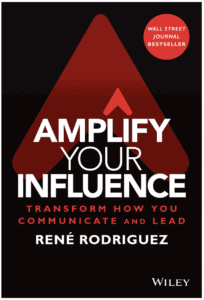
What presenters need to know about audiences
Book review
Amplify Your Influence: Transform How You Communicate and Lead

“We all have ideas to share with the world,” writes René Rodriguez.
Leaders, speakers, presenters, teachers and marketers need a playbook to maximize their influence. Amplify Your Audience: Transform How You Communicate and Lead is a new book that’s a worthwhile read for leaders, presenters, and communications coaches. Here are ideas you can use from the book.
Put sequence before substance
When you speak with an audience, the sequence matters more than the substance of what you say, Rodriguez writes. Work with the sequence of the brain, rather than trying to work against it, he advises.
Remember: it’s human nature to resist new ideas.
The brain has two big jobs, Rodriguez says. One is to protect you from the threat of death, the other is to make sense of sensory inputs. So a human brain is ready to fight even before a person feels any conscious awareness of a threat. And it reacts to a new idea the same way it reacts to a physical threat – with a fight, flight or freeze response.
To prepare audiences to receive your message, address their needs first. Answer people’s unstated questions:
- Am I safe? Make people feel comfortable. Leave their opinions unjudged. Use agendas, handshakes and rituals that make people feel safe.
- Do you care about me? Before an audience cares about a speaker, they need to know that the speaker cares about them and their best interests.
- Is this engaging? The logical side of the brain loves learning, logic and language. It seeks truth. Tell a story to trigger neurotransmitters that capture people’s attention.
- Is this inspiring? Does your content offer an idea that helps people in your audience align their future actions with their personal values?
To prepare your audience to receive your message, take these four steps before you offer up your main message or value proposition – which we call home in a Message Map.
Speakers need to stop and think about what might trigger resistance from an audience – and how to avoid it. Take steps in advance to prevent, pre-empt and prepare for expected resistance. For example, test your message with a small group before you roll it out to a big audience.
Do you tell your origin story?
To connect with audiences emotionally, tell an origin story that’s personal and vulnerable.
Origin stories answer questions about you: How you arrived where you are today? Why you love the people you serve?
A story with human struggle and eventual triumph motivates and persuades audiences, helping you to be remembered. To discover your own origin story and the roots of your values, reflect on who were your mentors or influencers when you were ages 9 through 11. When you share your values by telling your origin story, people connect with you emotionally.
Your ideas are seeds
Think of value propositions, messages and ideas as seeds. They can land on concrete, in the weeds or on fertile ground. Here’s a three-step process to prepare fertile ground for your message:
- Frame your message: it’s like tilling the soil. “In communication, either the speaker provides the frame or the listener will provide one unconsciously.”
- Deliver your message: It’s like planting the seed.
- Tie down the message. Tell the audience what it means for them. It’s like watering and nurturing the seed you planted.
Be gracious, grateful, confident, poised and approachable.
Leaders who have good self-awareness and higher emotional quotients (EQs) tend to succeed more often with audiences. The problem: “The smarter you are and the more successful you become, the harder it is to be self-aware.”
For example, when you walk down the hallway at work, do you interact in human ways with people around you or do you bury your face in your smartphone? It takes people only 3 seconds to form a first impression about you and decide whether or not they like you.
After each presentation, pay attention to feedback from your audiences. Review recordings and videos of your talks. Always debrief after a presentation.
Remember to LOVE your audiences:
- Listen to them.
- Observe their body language.
- Validate their feelings and experiences.
- Invite them to expand on their stories.
5 ideas to take away
Here are five of my top takeaways from the book:
- Just because your message is clear, doesn’t mean it has been heard. Audiences’ emotional states, cultural backgrounds, situational contexts, personal beliefs and stress levels all affect how people hear and listen to your message.
- People don’t need to be always right but they do want to feel heard. To help people feel heard, ask clarifying questions, paraphrase what they say, repeat back what you heard, check perceptions and be an active, attentive listener.
- To persuade, use all five tools from Aristotle’s rhetorical toolkit: logos (logic), pathos (emotion), ethos (credibility and character), kairos (timeliness) and telos (purpose).
- “Purchasing decisions are made with emotion and defended with logic.” To head off buyer’s remorse, make sure customers understand the logical case for keeping the things they buy.
- “Friction kills conversion.” Make conversion easy! Never force an audience do any extra thinking. Do their brainwork for them.





